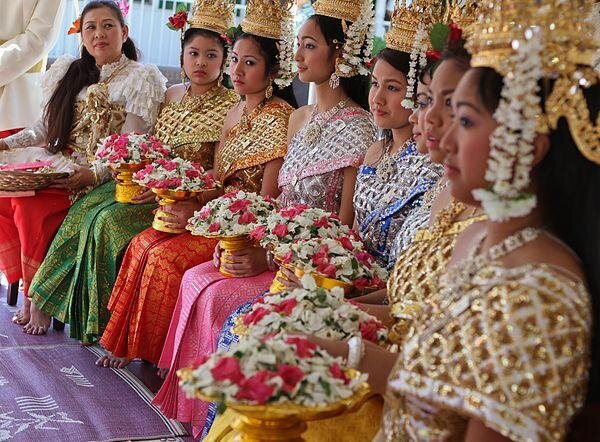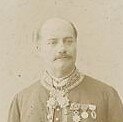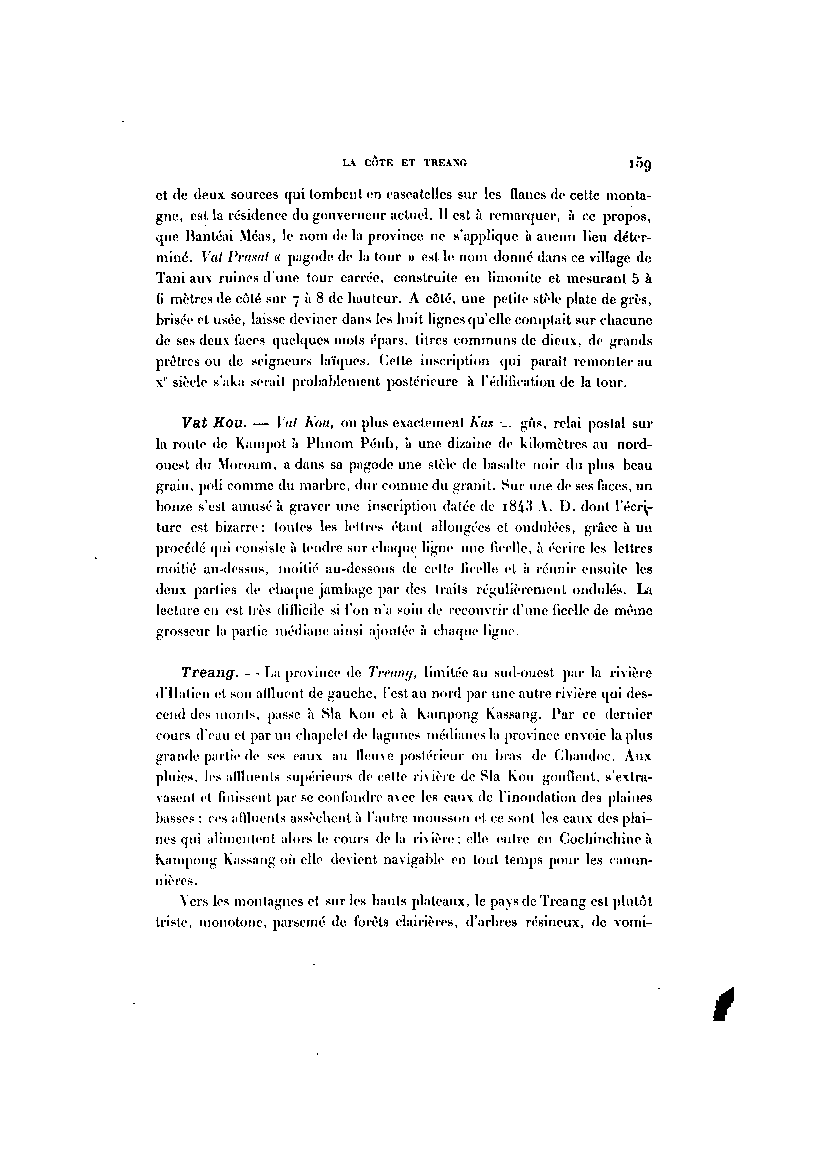Le Cambodge, t1-part 2
by Etienne Aymonier

Author: Etienne Aymonier
Pages: 535
Language : French
pdf 6.2 MB
About the Author

Etienne Aymonier
Étienne François Aymonier (26 Feb 1844, Le Chatelard, France – 21 Jan 1929, Paris), French naval officer, colonial administrator, linguist and explorer, was the first scientist to extensively survey the ruins and inscriptions of the Khmer empire in today’s Cambodia, Thailand, Laos and southern Vietnam, as well as the Cham civilization. Le Cambodge (three volumes published) from 1900 to 1904, remains to these days an important source for geographers, historians and epigraphists.
First director of the École Coloniale — where he also taught Khmer language since his retirement in 1905 -, he assembled a large collection of Khmer sculpture later housed in the Guimet Museum, Paris. They were major artworks that completed his stampings of Khmer and Cham inscriptions, yet in 1910 George Coedès complained they had not been properly labeled and sourced.
Author of a Dictionary of Cham-French (with Antoine Cabaton), a Khmer-French Lexicon and a Dictionary of Khmer, as well as a collection of Khmer texts, Textes khmers (1885), he was recognized as one of the first epigraphists working intensively in Cambodia, relying for the Sanskrit parts to the expertise of his friends Abel Bergaigne, Auguste Barth and Sylvain Lévi. In 1878, he transcribed the “Poem of Angkor Wat” (ល្បើកអង្គរវត្ត Lpoek Angkor Vat) in modern Khmer.
Fresh from St. Cyr Army School, he started as sublieutenant in Cochinchina in 1869 and, as adjunct to French Protectorate Representative Paul-Louis-Félix Philastre, prospected Kompong Thom province for his first officious exploration in 1876. While perfecting his knowledge of the Khmer language, he replaced Jean Moura as Protectorate plenipotenriary representative from 1 Jan 1879 to 10 May 1881, a function first occupied by Ernest Doudart de Lagree from April 1863 to July 1866. Indefatigable traveler, he crisscrossed Cambodia, Laos, Vietnam, from 1881 to 1885, gathering essential information.
While Aymonier trained numerous local volunteers (Cambodian, Laotian and Vietnamese) to mastering archaeological and epigraphic techniques, and acknowleged their contribution in his writings — paying homage to “a collaborator named An, in particular” (Introduction to Le Camboge, I, 1900), he somehow remained a maverick in the field of Khmer and Cham studies. According to Cristina Cramerotti (trad. Jennifer Donnelly), author of Collectionneurs, collecteurs et marchands d’art asiatique en France 1700 – 1939 INHA), “neither the “field” scientist nor the administrator enjoyed unanimous support whether in academic circles or the hierarchy. While he contributed to bringing the future École française d’Extrême-Orient to the baptismal font, a bitter controversy over Funan pitted him against Paul Pelliot (1878−1945) who reproached him for his dangerous individualism in scientific matters [see details of their confrontation in the latter’s ADB biographical note]. His self-taught side bothered scholars: his candidacy as a free member of the Académie des inscriptions et belles-lettres, which had once praised him, was refused twice. He developed some resentment. In addition, his character, sometimes described as “rough”, his independence of mind, and the proposals for reform of the colonial administration, expressed in a rather abrupt way, ended up doing him a disservice.”
In his 1929 [rather acrimonious] obituary, George Coedès wrote
C’est l’un de ces articles [Aymonier’s] relatif au Fou-nan qui déclencha une polémique dont le résultat le plus triste fut d’aliéner à l’Ecole Française la sympathie d’un homme qui aurait eu tant de raisons de travailler en étroite collaboration avec elle, et qui, dans l’introduction de son Cambodge, saluait «la création de cette Ecole d’Extrême-Orient qui est un résultat très direct de ma mission archéologique qu’elle doit continuer dans des conditions infiniment plus favorables à tous les points de vue». Il avait commis l’imprudence, lui, qui n’avait aucune connaissance sinologique, de s’en prendre aux sinologues: genus irritabile ! La riposte de M. Pelliot lui causa une blessure d’amour-propre qui empoisonna les vingt-cinq dernières années de sa vie. et qu’il ressentait encore à la veille de sa mort. Sous le prétexte de mettre l’histoire ancienne du Cambodge à la portés de tous, ses deux derniers opuscules, oeuvres séniles sur lesquelles il serait cruel d’insister, n’eurent d’autre objet que de défendre une cause depuis longtemps perdue et classée. Heureusement, le travail de collaboration entre lui et M. Cabaton, qui devait aboutir en 1906 à la publication du Dictionnaire cam-français, était déjà presque terminé en 1904, et l’Ecole Française d’Extrême-Orient a ainsi la satisfaction de pouvoir inscrire le nom d’Aymonier parmi ceux de ses collaborateurs. Lorsque le progrès des études aura relégué ses travaux au nombre des ouvrages qui n’ont plus qu’un intérêt bibliographique, l’oeuvre accomplie pendant sa mission de 1882 – 1885 qui fonda l’épigraphie khmère sur une base solide et ressuscita les Chams ignorés avant lui, cette oeuvre subsistera comme un témoignage de son labeur et de son dévouement à la science, et suffira à assurer à son nom une place éminente dans l’histoire des études indochinoises.
[It was one of these articles [Aymonier’s] relating to Fou-nan which triggered a controversy whose saddest result was to alienate from the French School the sympathy of a man who would have had so many reasons to work in close collaboration with the School, and who, in the introduction to his Cambodia, welcomed “the creation of this Far Eastern School, a very direct result of my archaeological mission which it must continue in infinitely more favorable conditions from all points of view”. He, who had no sinological knowledge, had been imprudent in attacking the sinologists: genus irritabile! Mr. Pelliot’s response caused an injury to his self-esteem which poisoned the last twenty-five years of his life, and which he still felt on the eve of his death. Under the pretext of making the ancient history of Cambodia accessible to all, his last two pamphlets [Un aperçu de l’histoire du Cambodge, Paris, 1918, and Histoire de l’ancien Cambodge, Strasbourg, nd] senile works on which it would be cruel to dwell, had no other purpose than to defend a cause long lost and cold. Fortunately, the collaborative work between him and Mr. Cabaton, which was to lead in 1906 to the publication of the Dictionnaire cam-français, was already almost finished in 1904, and EFEO thus has the satisfaction of being able to include the name of Aymonier among those of his collaborators. When the progress of studies will have relegated his works to the number of works which no longer have more than a bibliographical interest, the work accomplished during his mission of 1882 – 1885, which founded Khmer epigraphy on a solid basis and resurrected the ignored Chams before him, this work will remain as a testimony to his work and his dedication to science, and will be enough to ensure his name an eminent place in the history of Indochinese studies.
Tough love.
Publications (publications added from G. Coedès and ADB research)
- “Les Monuments du Cambodge meridional”, Revue orientale et americaine, ed. Leon de Rosny, t. 1 new series, 1876.
- “Excursion dans le Cambodge central”, Bulletin de la Société de géographie (BSG), 1882, pp. 656 – 663.
- “Critique du “Royaume du Cambodge” de M. Moura”, Excursions et Reconnaissances (E&R), XVI, 1883, pp. 207 – 220.
- “Exploration au Cambodge, lettre de Saigon du 11 août 1883”, compte-rendu des séances de la SG, 9 Nov. 1883, pp. 486 – 490.
- “Notes sur les coutumes et croyances superstitieuses des Cambodgiens”, E&R, XVI, 1883, pp. 133 – 206.
- “Quelques notions sur les inscriptions en vieux khmer”, Journal Asiatique (JA), 1883 (1), pp 441 – 505; (2), pp. 199 – 228.
- “L’épigraphie kambodjienne”, E&R, XX, 1884, pp. 253 – 296.
- “Lettre sur son voyage au Binh-Thuan, adressée à M. le Gouverneur de la Cochinchine. E&R, XXII, 1885, pp. 247 – 254.
- “Les Chams”, Revue d’ethnographie (RE), IV, 1885, pp. 158 – 160.
- “Notes sur le Laos. Région du Sud-Est, détails géographiques”, E&R, XX, 1884, pp. 35 – 386; XXI, 1885, pp. 5 – 130; XXII, 1885, pp. 255 – 347.
- “Notes sur l’Annam. I. Le Binh-Thuan. II, Le Khanh-Hoa”, E&R, XXIV, 1885, pp, 199 – 340; XXVI, 1886, pp. 179 – 218; XXVII, 1886, pp. 5 – 29.
- “Nos transcriptions. Étude sur les systèmes d’écriture en caractères européens adoptés en Cochinchine française”, E&R, XXVII, 1886, pp. 31 – 89.
- “Grammaire de la langue chame”, E&R, XXXI, 1889, pp. 5 – 92.
- “Annam et Tonkin. Colonies françaises et Pays de protectorat à l’Exposition uni. de 1889”, Guide, pp. 27 – 37.
- “Légendes historiques des Chames”, E&R, XXXII, 1890, pp. 145 – 206.
- La langue française et l’enseignement en Indo-Chine, Paris, 1890, in‑8°.
- “La langue française en Indo-Chine”, Revue scientifique (RS)., 1891.
- “Les Tchames et leurs religions”, Revue d’histoire des religions (RHR), 189 1, XXIV, pp. 187 – 237; 261 – 315.
- “Première étude sur les inscriptions tchames”, JA, 1891 (1), p. 5 – 186.
- Communication sur la fondation de la dynastie cambodgienne, compte-rendu Academie des Inscriptions et belles lettres (AIBL), 1891, p. 429 – 430.
- “Une mission en Indo-Chine. Relation sommaire”, BSG, 1892, pp. 216 – 249, ЗЗ9 – 374.
- “The history of Tchampa (The Cyamba of Marco Polo, now Annam or Cochin-China)”, publication of the 9t International Congress of Orientalists, London., VI, 1893, p. 140 and 365.
- “Sommaire des travaux relatifs à l’Inio-Chine pendant la période 1886 – 1891, ibid, 1893.
- “Découvertes or héologiques de M. Camille Paris dans la province de Quang-nam. Inscriptions découvertes par M. C. Paris au Tchampa”, Bulletin de Géographie, Histoire et Descriptions (BGHD), 1896, pp. 92 – 95; pp 329 – 330.
- “Rapport sommaire sur les inscriptions du Tchampa, découvertes et estampées par les soins de M. Camille Paris”, JA., 1896 (1), pp. 146 – 151.
- “Note sur les derniers envois de M. C. Paris, chargé d’une mission en Annam. BGHD, 1897, pp. 389 – 390.
- “Rapport sur le dernier mémoire de M. Camille Paris”, BGHD, 1898, pp. 247 – 249.
- Mission Etienne Aymonier. Voyage dans le Laos, Annuaire Musée Guimet, Bibliotheque d’études, V‑VI. Paris, 1895 – 1897, 2 vol. in‑8°.
- “Le Cambodge et ses monuments. La province de Ba Phnom”, JA, 1897 (1), pp. 185 – 222.
- “Le Cambodge et ses monuments. Koh Kêr, Phnom Sandak, Phnom Prah Vihear”, RHR, XXXVI, 1897, pp. 20 – 54.
- “Découvertes épigraphiques de M. C[amille] Paris, JA., 1898 (2), pp. 359 – 360.
- “Le roi Yašovarman”,Actes du XIe Congres international des orientalistes, 2e section (langues et archéologie de l’Extreme-Orient, p. 191. Paris, 1898.
- “Communication sur une inscription chame trouvée par le P. Durand à Kon Tra”, JA, 1899 (2), pp. 544 – 545.
- “Les inscriptions du Preah Peân (Angkor Vat)”, JA, 1899 (2), pp. 493 – 529.
- “Les inscriptions du Bakan et la grande inscription d’Angkor Vat”, JA,1900 (1), pp. 143 – 175.
- “La stèle de Sdok Kâk Thom”, JA, 1901 (1), pp. 5 – 52.
- “Le Founan”. JA, 1903 (1), pp. 109 – 150.
- “Le Siam ancien”, JA., 1903 (1), pp. 185 – 239.
- “Nouvelles observations sur le Founan”, JA, 1903 (2), pp. 333 – 341.
- “Les fondateurs d’Angkor Vat”, Album Kern, Leide, 1903, p 165.
- Le Cambodge, Paris, 1900 – 1904, 3 vol.
- “Identification de noms de lieux portés sur les cartes publiées par M. Marcel dans le Siam ancien de M. Fournereau”, BGHD, 1905, pp. 43 – 44.
- [with A. Cabaton], Dictionnaire cam-français, PEFEO, vol. VII, Paris, 1906, in‑8°.
- “L’inscription came de Po Sah”, BCAI, 1911, pp. 13 – 19.
- Un aperçu de l’histoire du Cambodge, Paris, 1918, in-12.
- Histoire de l’ancien Cambodge, Strasbourg, s. d.
[Numerous pieces brought from Cambodia by Aymonier were exhibited at the Musée Guimet “Exposition des résultats des voyages et explorations scientifiques en Asie : Religions, arts, archéologie et ethnographie”, Paris, 1893.]

